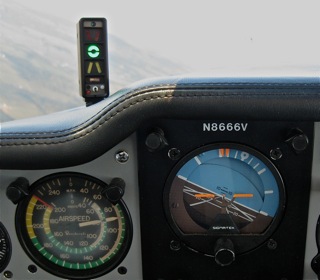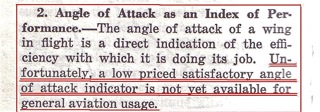Now, here's a really nice device. It's an It could easily save a lot of lives.  It's not at all costly (it's free to a Flight School or CFI) and it provides superb information about the one thing that most light aircraft panels do not show us....that is the Angle of Attack of our wing. It's not at all costly (it's free to a Flight School or CFI) and it provides superb information about the one thing that most light aircraft panels do not show us....that is the Angle of Attack of our wing.
Read the flight tests. and the
recently published articles
Having the Stall Warning System Legacy display sitting up high in front of our eyes... and ESPECIALLY when our eyes are outside the cockpit and we hear an Early Warning "Deedle-Deedle" tone or an alert tone and female voice "DingDong! Getting Slow"... makes for a wonderfully comforting device. (Listen to Slow Sarah - "Getting Slow") This latest software incorporates some really good thinking. The alerts now fire off only when AoA is increasing. That trend-sampling removes a lot of unnecessary alerts that earlier, more primitive, systems occasionally gave. Here's a fuller explanation of how the upgraded Legacy functions and some thoughts on how to use an AoA in normal flight...and a variation when using a simple AoA for long range cruise
HUGELY IMPORTANT! ... SOME RECENT NEWS! ...
. Also in October 2015, they updated the FAA Currency Requirements and Guidance for the Flight Review and Instrument Proficiency Checkguide with a new emphasis on AOA (see page 16, Paragraph 4-3d) How To Review AoA during IPC flights.
Read the full FAA inFO document here.
Earlier, in its extraordinarily helpful December 2011 FAA clarification letter, the FAA Small Aircraft Directorate explains that installation is a "minor alteration" on the vast majority of light general aviation aircraft.
Please join in our thanks to the FAA Small Aircraft Directorate.
All aviators know that Angle Of Attack (“Alpha”) at stall is NOT affected by variances in aircraft cabin or fuel loads, or by density altitude or by angle of bank,
Every aviator is taught and knows the critically important “Angle of Bank v. G-Force” curve. But there is not a pilot flying who has the ability to compute his constantly-changing margin above stall (a Vref, or an Optimal Alpha Angle) especially when operating with varying loads in a bank on a hot muggy day at altitude. An Alpha-sensing system can do that easily and accurately in real-time. Operationally, Alpha is critically important; accordingly, most heavier aircraft have some sort of Alpha-sensing system on board.
Lighter general aviation aircraft have never really had a good AoA indicator available at a reasonable cost. Now, we do; an elegantly simple device that constantly computes and displays a safe airspeed buffer. My “Slow Sarah” is a totally trustworthy observer. She always watching one thing only: my margin above stall.
Talk or reality? Click here to read four independent flight tests that may help you understand more..
The FAA has known the importance of Angle of Attack instrumentation for decades, but -- only recently -- low cost modern electronics have become available to do the job -- affordably -- in light aircraft. This was published by the FAA in 1964.
FAA Flight Instructor's Handbook - 1964

Clearly, the FAA would have enthusiastically encouraged installing AoA instrumentation in training aircraft back then, but they publicly lamented its affordability.
Incidentally, the FAA guidance for stall warning devices has NEVER said "it has to be a 'too-late warning' or an 'inadequate warning'." There is NOTHING in the guidance that prevents a better or earlier from being installed. Today, with modern electronices to provide a "HELPFUL WARNING", we can install a highly-accurate EARLY WARNING of STALL AoA system for well under $1,500
... and... in December 2011, the FAA writes that it agrees!
Please read the FAA Letter of Clarification.
The most experienced aviators ALL agree that AoA is the way to go. Consider this from FLYING Magazine, November 1971, by Robert Blodgett, Contributing Editor:
“Two things are certain: The first is that AoA indicators could do more than anything else in the history of powered flight to reduce accidents, especially fatals. The second is that only customer demand can convince manufacturers that people want “Alpha”.
“Stall warning devices are …binary or ‘On-Off’ devices that give the pilot no indication whatever on how close his wing is to stall….one or two degrees [of angle of attack] below stall, a [stall warning device] is still speechless, mute. It is at its most awkward, tongue-tied phase just when the pilot needs it most..."
BINGO! A wiser sentence on aviation instrumentation may have never been written.
The same week that article was published, I ordered a Safe Flight Instruments SC-100 AoA for my Bonanza 36. I flew behind that wonderful device for 20+ years. The is similar but its modern electronics are lot more advanced. So, how does it work?
Click here to see how the Legacy AoA functions. What does the instrument display? What can it not do?
INSTALLATION? It's easy. Read this. For most aircraft it's a "minor alteration"
For locations to mount the Alpha probes, the sensors, please click....
... and here a few good locations to mount the AoA displays
and a few ideas on routing the sensor lines.
Please download our Test Flight Report PFD files here. These have been placed in the public domain so that any AoA manufacturer can benefit from our research:
S35 Bonanza Legacy Angle of Attack -Test Flight Final Report
King Air 90 Blackhawk Legacy Angle of Attack - Test Flight Final Report
Human Factors - A Prototype Version - Enhanced Audio & Cascading Lights
Dual Indicators - the Eagle AoA in the King Air 90
"Flap Biasing" AoA in the King Air C90 Blackhawk
Here's the ENTIRE FINAL REPORT on the TEST FLIGHTS
...and a briefer EXECUTIVE SUMMARY:
The Alpha Systems Angle of Attack (AoA) Stall Warning System offers an accurate, repeatable, and very early warning of impending aerodynamic stall. Such clear stall proximity information mounted prominently on the glareshield in full view of the pilot offers enhanced safety in the operation of general aviation aircraft.
A display of AoA as a cross-check to the primary Airspeed Indicator is particularly useful when operating in steeply banked and/or G-loaded flight conditions because the angle of attack at aerodynamic stall is independent of aircraft weight and/or wing loading.
Specifically, within the scope of these test flights, the following germane conclusions were reached:
• The “Optimum Alpha Angle (OAA) Calibration” technique recommended by the Alpha Systems AoA Stall Warning System Installation Manual is an accurate and repeatable method that can be used to reliably set an AoA target that will be adequately before the aerodynamic stall AoA.
• The target AoA, once calibrated, presents data to the pilot so as to provide early warning of an impending stall, prior to the aircraft stall warning audible system, thereby ensuring a safe margin above stall throughout the entire gross weight envelope.
• The instrumentation provides clear, un-ambiguous, and easy-to-comprehend stall proximity information.
NOTE: Some readers have asked why we suggested flap-biasing [after subsequent test flights, we withdrew that suggestion] of AoA data for future products when we didn't observe much--if any--flap effect on AoA in the Bonanza and King Air. Plain flaps, split flaps, and slotted flaps at high AoA do not incur significant Coefficient of Lift (CLmax) shifts from the basic wing section, but Fowler-type flaps can and often do. Accordingly, for wide-span Fowler flap-equipped light aircraft---but there aren't many---flap bias may well be a good idea. The Bonanza and King Air have "de facto" slotted flaps, of course, with only a small initial Fowler action.
OTHER VOICES: Read comments from pilots with recent fight experience using this particular AoA device, with AoA flight time in military aircraft, and in using AoA devices in general aviation aircraft. Read what a few Flight Instructors and FAA-Designated Pilot Examiners think about it. As you read along, please notice that all are pilots with great experience...the most highly skilled among us...CFI's and Flight Examiners...and ... EVERY ONE of them is savvy enough and humble enough to know that there are VERY GOOD REASONS for having an Angle of Attack indicator on the glareshield.
Here is a recent...and excellent...short video showing an AoA prominently displayed in the
In addition, please read these...
Collected Articles and Publications
Unsolicited Web Postings
More Unsolicited Web Postings
Two Civilian pilots who Became Military Aviators and FAA Check Airmen
The FAA Small Aircraft Directorate concurs that on most light general aviation aircraft, the Alpha Systems AoA is a minor alteration.
I
n June 2015 the FAA rolled out its . The FAA is making a big push to get AoA indicators installed in General Aviation aircraft.
Finally, here is a list of all the AoA manufacturers that I'm aware of.
...and ... recent articles in the aviation press.
Here: more published documents on Alpha displays
...and a few web-posts on the AoA subject by experienced aviators
and here, more web-posts by experienced pilots using AoA displays.
More: a very interesting discussion with two very skilled pilots, each with civilian-to-military training, both now flying the King Air 300/350
What will an AoA Display NOT do? When we hear "How much better will my aircraft perform with a AoA installed?"... my answer has always been: "NOT ONE LITTLE BIT BETTER." None of us need an AoA and the aircraft will fly perfectly well without one. But an AoA WILL PROVIDE much greater comfort and security by letting an aviator KNOW FOR SURE what stall margin remains available...and with that knowledge, it becomes a lot safer (or: more secure, comforting, less risky...) to approach the limits of the aircraft's performance envelope. An AoA can make a good pilot better and enable her to fly more precisely, but it won't reduce the POH-specified landing roll by a single foot, nor increase the range by a mile, nor increase the rate of climb by 1FPM, etc. ....
Who makes these sensors and displays? Click here.
+++++++++++++++++++++++++++++++++
I have NO financial interest in this company or its products...but I will say---having lost a few too many pals in low-level stall/spins, that I will do everything I can to help them succeed. So will my friend Tom Rosen in California. He recently lost two 30,000-hour (each) airline captains. Close friends gone. Together, Tom and I are trying to prevent these steep-turn crashes from happening again.
|






